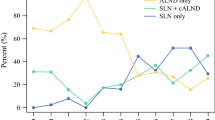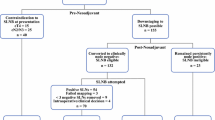Abstract
Background
In the ACOSOG (American College of Surgeons Oncology Group) Z0011 trial and the AMAROS (After Mapping of the Axilla: Radiotherapy or Surgery?) trial, matted nodes with gross extracapsular extension (ECE), a risk factor for locoregional recurrence, were an indication for axillary lymph node dissection (ALND), but the effect of microscopic ECE (mECE) in the sentinel lymph nodes (SLNs) on recurrence was not examined.
Methods
Between 2010 and 2017, 811 patients with cT1-2N0 breast cancer and SLN metastasis were prospectively managed according to Z0011 criteria, with ALND for those with more than two positive SLNs or gross ECE. Management of mECE was not specified. In this study, we compare outcomes of patients with one to two positive SLNs with and without mECE, treated with SLN biopsy alone (n = 685).
Results
Median patient age was 58 years, and median tumor size was 1.7 cm. mECE was identified in 210 (31%) patients. Patients with mECE were older, had larger tumors, and were more likely to be hormone receptor positive and HER2 negative, have two positive SLNs, and receive nodal radiation. At a median follow-up of 41 months, no isolated axillary failures were observed. There were 11 nodal recurrences; two supraclavicular ± axillary, four synchronous with breast, and five with distant failure. The five-year rate of any nodal recurrence was 1.6% and did not differ by mECE (2.3% vs. 1.3%; p = 0.84). No differences were observed in local (p = 0.08) or distant (p = 0.31) recurrence rates by mECE status.
Conclusions
In Z0011-eligible patients, nodal recurrence rates in patients with mECE are low after treatment with SLN biopsy alone, even in the absence of routine nodal radiation. The presence of mECE should not be considered a routine indication for ALND.


Similar content being viewed by others
References
Donker M, van Tienhoven G, Straver ME, et al. Radiotherapy or surgery of the axilla after a positive sentinel node in breast cancer (EORTC 10981-22023 AMAROS): a randomised, multicentre, open-label, phase 3 non-inferiority trial. Lancet Oncol 2014;15(12):1303–10.
Giuliano AE, Ballman KV, McCall L, et al. Effect of axillary dissection vs no axillary dissection on 10-year overall survival among women with invasive breast cancer and sentinel node metastasis: the ACOSOG Z0011 (Alliance) randomized clinical trial. JAMA 2017;318(10):918–26.
Giuliano AE, Hunt KK, Ballman KV, et al. Axillary dissection vs no axillary dissection in women with invasive breast cancer and sentinel node metastasis: a randomized clinical trial. JAMA 2011;305(6):569–75.
Morrow M, Van Zee KJ, Patil S, et al. Axillary dissection and nodal irradiation can be avoided for most node-positive z0011-eligible breast cancers: a prospective validation study of 793 patients. Ann Surg 2017;266(3):457–62.
Bucci JA, Kennedy CW, Burn J, et al. Implications of extranodal spread in node positive breast cancer: a review of survival and local recurrence. Breast 2001;10(3):213–9.
Nottegar A, Veronese N, Senthil M, et al. Extra-nodal extension of sentinel lymph node metastasis is a marker of poor prognosis in breast cancer patients: a systematic review and an exploratory meta-analysis. Eur J Surg Oncol 2016;42(7):919–25.
Pierce LJ, Oberman HA, Strawderman MH, Lichter AS. Microscopic extracapsular extension in the axilla: is this an indication for axillary radiotherapy? Int J Radiat Oncol Biol Phys 1995;33(2):253–9.
Gooch J, King TA, Eaton A, et al. The extent of extracapsular extension may influence the need for axillary lymph node dissection in patients with T1-T2 breast cancer. Ann Surg Oncol 2014;21(9):2897–903.
van la Parra RF, Peer PG, Ernst MF, Bosscha K. Meta-analysis of predictive factors for non-sentinel lymph node metastases in breast cancer patients with a positive SLN. Eur J Surg Oncol 2011;37(4):290–9.
Aziz S, Wik E, Knutsvik G, et al. Extra-nodal extension is a significant prognostic factor in lymph node positive breast cancer. PLoS ONE 2017;12(2):e0171853.
Gray RJ. A class of K-sample tests for comparing the cumulative incidence of a competing risk. Ann Stat 1988;16:1141–54.
Rutgers EJ, Donker M, Poncet C, et al. Radiotherapy or surgery of the axilla after a positive sentinel node in breast cancer patients: 10 year follow up results of the EORTC AMAROS trial (EORTC 10981/22023) [abstract no. GS4-01]. 41st Annual San Antonio Breast Cancer Symposium, 4–8 Dec 2018; San Antonio, TX.
Choi AH, Blount S, Perez MN, et al. Size of extranodal extension on sentinel lymph node dissection in the American College of Surgeons Oncology Group Z0011 trial era. JAMA Surg 2015;150(12):1141–8.
Hetelekidis S, Schnitt SJ, Silver B, et al. The significance of extracapsular extension of axillary lymph node metastases in early-stage breast cancer. Int J Radiat Oncol Biol Phys 2000;46(1):31–4.
Leonard C, Corkill M, Tompkin J, et al. Are axillary recurrence and overall survival affected by axillary extranodal tumor extension in breast cancer? Implications for radiation therapy. J Clin Oncol 1995;13(1):47–53.
Fisher BJ, Perera FE, Cooke AL, et al. Extracapsular axillary node extension in patients receiving adjuvant systemic therapy: an indication for radiotherapy? Int J Radiat Oncol Biol Phys 1997;38(3):551–9.
Giuliano AE, Ballman K, McCall L, et al. Locoregional recurrence after sentinel lymph node dissection with or without axillary dissection in patients with sentinel lymph node metastases: long-term follow-up from the American College of Surgeons Oncology Group (Alliance) ACOSOG Z0011 randomized trial. Ann Surg 2016;264(3):413–20.
Funding
The preparation of this study was funded in part by NIH/NCI Cancer Center Support Grant No. P30 CA008748 to Memorial Sloan Kettering Cancer Center.
Author information
Authors and Affiliations
Corresponding author
Ethics declarations
Disclosure
Dr. Andrea V. Barrio has received speaking honoraria from Roche; Dr. Monica Morrow has received honoraria from Genomic Health and Roche; Dr. Kimberly J. Van Zee served on the advisory board of Genomic Health in 2012; and Dr. Mahmoud El-Tamer has received honoraria from Blue Earth Diagnostic. Stephanie Downs-Canner, Marcia Edelweiss, Hiram S. Cody III, Mary L. Gemignani, Melissa L. Pilewskie, George Plitas, Laurie Kirstein, Deborah Capko, and Sujata Patil have no conflict of interest disclosures to report.
Additional information
Publisher's Note
Springer Nature remains neutral with regard to jurisdictional claims in published maps and institutional affiliations.
Rights and permissions
About this article
Cite this article
Barrio, A.V., Downs-Canner, S., Edelweiss, M. et al. Microscopic Extracapsular Extension in Sentinel Lymph Nodes Does Not Mandate Axillary Dissection in Z0011-Eligible Patients. Ann Surg Oncol 27, 1617–1624 (2020). https://doi.org/10.1245/s10434-019-08104-1
Received:
Published:
Issue Date:
DOI: https://doi.org/10.1245/s10434-019-08104-1




